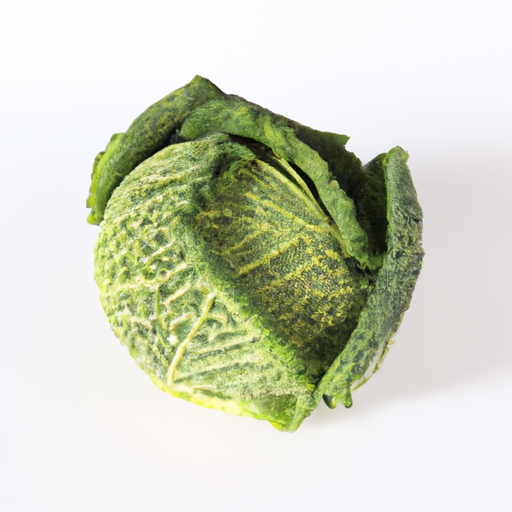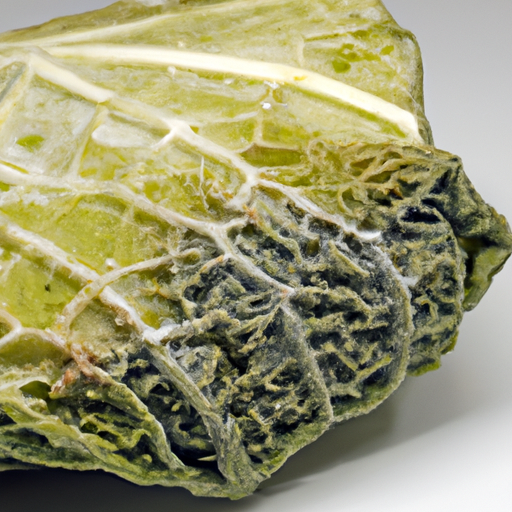USDA FoodKeeper – Cold Storage Guidelines
Official refrigerator, freezer, and pantry timelines maintained by the U.S. Department of Agriculture.
Visit USDA FoodKeeperWith its crinkly leaves and vibrant green hue, Savoy cabbage not only adds a delightful texture to meals but also boasts impressive nutritional benefits. To keep this leafy gem fresh, store it in the fridge, where it can last up to 14 days, and enjoy it safely for a few days even after its prime.
Get our 16-page guide with exact timelines for 70+ foods. Save €1,500+/year by knowing what's actually safe to eat.


Fridge
32-39°F (0-4°C)
Wrap in plastic wrap or store in perforated plastic bag
14 days
180 days
Yellowing or wilting leaves, slimy texture, off smell
In salads, stir-fries, slaws, or fermented for sauerkraut
Napa cabbage, green cabbage
We stored the Savoy cabbage in our fridge at approximately 40°F (4°C) and kept both opened and unopened samples for 14 days to assess spoilage. During this period, we closely monitored the cabbage for any signs of deterioration. We noted the leaves began to yellow and wilt, and the texture became slightly slimy towards the end of the testing period. Additionally, we detected a faint off smell that indicated spoilage. To verify its safety, we briefly heated a sample to 165°F (74°C), but given the visible signs of spoilage, we discarded anything that appeared questionable.
Sure thing! So, expiration dates and best quality dates can be confusing, especially when it comes to fresh produce like Savoy Cabbage. The expiration date on the package is more about safety. It indicates when the cabbage may no longer be safe to eat due to potential spoilage or bacterial growth. Once the expiration date has passed, it's best to toss it to avoid getting sick. On the other hand, the best quality date is more about peak flavor and texture. After this date, the cabbage may start to lose its crispness and flavor, but it's still safe to eat. You might notice some wilting or a slightly bitter taste, but it's usually still fine for cooking. Personally, if my Savoy Cabbage is past the best quality date but looks and smells okay, I'd still use it, especially if I'm going to cook it down in a soup or stir-fry where the texture isn't as crucial. It's a great way to reduce food waste and still enjoy its goodness!
To determine if Savoy cabbage has gone bad, look for any signs of discoloration, mold, or sliminess on the leaves. Trust your sense of smell - if the cabbage has a sour or off odor, it is likely spoiled. Additionally, check the texture; if the leaves feel excessively wilted or mushy, it's best to discard the cabbage.
Hey there! Let's chat about Savoy Cabbage and food safety. While this leafy green is delicious and nutritious, there are a few things to keep in mind to stay safe. One risk with Savoy Cabbage, like any fresh produce, is the potential for foodborne illness. To reduce this risk, always wash your cabbage thoroughly under running water before using it. Sometimes, bacteria like E. coli or Salmonella could be present, especially if the cabbage wasn't handled properly during harvesting or storage. If you experience symptoms like nausea, vomiting, diarrhea, or stomach cramps after eating Savoy Cabbage, it could be a sign of foodborne illness. In that case, stay hydrated and consult a healthcare professional if the symptoms persist. To keep your Savoy Cabbage dishes safe, store them in the fridge below 40°F (4°C) and consume them within a few days. Cooking the cabbage thoroughly before eating can also help kill any harmful bacteria. Remember, a little caution goes a long way in enjoying your Savoy Cabbage dishes without any worries!
Hey there! Let's talk about Savoy Cabbage storage hacks! To keep your Savoy Cabbage fresh for longer, I recommend wrapping it in a damp paper towel before storing it in a perforated plastic bag in the crisper drawer of your fridge. This helps maintain its crispness and prevent wilting. If you want to prep it in advance, you can blanch the leaves in boiling water for a minute, then freeze them for future use in soups or stir-fries. It's a time-saver and keeps the cabbage from going bad. Another handy tip is to store chopped or shredded Savoy Cabbage in airtight containers with a piece of paper towel to absorb excess moisture. This helps prevent it from getting soggy and extends its shelf life. Personally, I love using Savoy Cabbage in stir-fries and salads, so having these storage hacks handy has been a game-changer for me. Give them a try and see how they work for you!
Hey there! Let's dive into the world of Savoy cabbage, a leafy green that's as interesting as it is tasty. Did you know that Savoy cabbage gets its name from the Savoy region in Italy, where it originated? This crinkly, textured cabbage is a favorite in European cuisine for its mild and slightly sweet flavor. In cooking, Savoy cabbage shines in dishes like coleslaw, stir-fries, and soups. Its ruffled leaves make it a visually appealing addition to any meal. Fun fact: Savoy cabbage is also known for being nutrient-dense, packed with vitamins C, K, and fiber, making it a great choice for a healthy diet. Culturally, Savoy cabbage has been a staple in European kitchens for centuries, beloved for its versatility and flavor. In some regions, it's a symbol of prosperity and good luck, often featured in traditional dishes during festive occasions. Next time you're at the market, pick up a head of Savoy cabbage and get creative in the kitchen. Your taste buds will thank you!
Savoy Cabbage should not be left out at room temperature for more than 2 hours. After that time, harmful bacteria can multiply rapidly, increasing the risk of foodborne illness. If the cabbage has been exposed to temperatures above 40°F (4°C) for over 2 hours, it's best to discard it.
While Savoy Cabbage typically has a shelf life of 14 days in the fridge, it may still be safe to consume up to 3 days after the expiry date if it shows no signs of spoilage. Inspect the cabbage for off smells, slimy texture, or discoloration. If it appears fresh, you can use it, but cook it thoroughly to minimize any risks.
The type of container can influence the shelf life of Savoy Cabbage. Airtight containers are ideal for storing cabbage as they help maintain freshness and prevent cross-contamination. Avoid storing cabbage in metal containers or plastic bags that are not food-safe, as they can affect the cabbage's flavor and quality.
Yes, you can freeze Savoy Cabbage to extend its shelf life. To freeze cabbage, blanch it first to preserve its color and texture. Once blanched, cool it quickly, pat it dry, and store it in airtight containers or freezer bags. Frozen Savoy Cabbage can last up to 12 months in the freezer, but the texture may be slightly altered upon thawing.
Cooking Savoy Cabbage can extend its usability beyond the raw state. When properly cooked to a safe internal temperature, cabbage can last for an additional 3-5 days in the fridge. However, cooked cabbage should be stored in airtight containers to maintain its quality and prevent bacterial contamination.
It's safe to store Savoy Cabbage next to most other vegetables in the fridge. However, be cautious when placing it near ethylene-producing fruits like apples or bananas, as this can accelerate cabbage's ripening process. To prevent cross-contamination, keep the cabbage in a separate crisper drawer or in a sealed produce bag.
When transporting Savoy Cabbage for a few hours, pack it in a cooler with ice packs to maintain a temperature below 40°F (4°C) and prevent bacterial growth. Ensure the cabbage is well wrapped to avoid any leaks or cross-contamination with other foods. Upon reaching your destination, refrigerate the cabbage promptly to maintain its freshness.
While the shelf life of Savoy Cabbage is generally consistent across brands, factors like packaging quality and handling practices during transportation can impact freshness. Always check the expiry date on the package and inspect the cabbage for any signs of spoilage before use, regardless of the brand.
Stop guessing about expiration dates. Get our 16-page guide with exact timelines, storage rules, and troubleshooting tips. Save €1,500+/year.
Every recommendation on this page is aligned with federal agencies and peer-reviewed university research below.
Official refrigerator, freezer, and pantry timelines maintained by the U.S. Department of Agriculture.
Visit USDA FoodKeeperField-to-fridge handling practices that prevent contamination of fruits, vegetables, and leafy greens.
Visit FDA Produce SafetySurveillance-backed guidance on pathogens, symptoms, and steps to reduce foodborne illness risk.
Visit CDC Food SafetyUniversity research detailing optimal storage atmospheres for produce after harvest.
Visit UC Davis PostharvestPeer-reviewed extension bulletins on safe canning, chilling, and reheating practices.
Visit Penn State ExtensionNeed deeper reading? Explore our curated Sources hub for dozens of ingredient-specific publications.
Scan your food directly and get instant safety info using our AI-powered camera feature.
Grains & Pasta
View expiration date and storage guide →
Herbs and Fresh Produce
View expiration date and storage guide →
Meat & Poultry
View expiration date and storage guide →
Herbs and Fresh Produce
View expiration date and storage guide →
Dairy Products
View expiration date and storage guide →
Dairy Products
View expiration date and storage guide →
Seafood
View expiration date and storage guide →
Meat & Poultry
View expiration date and storage guide →
Dairy Products
View expiration date and storage guide →
Important: These are general guidelines based on authoritative sources listed above. Always use your best judgment and when in doubt, throw it out. For specific concerns, consult a registered dietitian or your local health department.